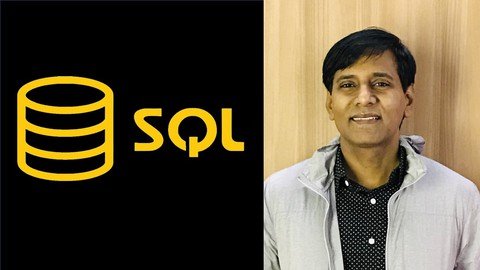
Published 08/2022
Genre: eLearning | MP4 | Video: h264, 1280×720 | Audio: AAC, 44.1 KHz
Language: English | Size: 3.46 GB | Duration: 55 lectures • 7h 30m
Learn how to retrieve and manipulate data in Database using SQL
What you’ll learn
What is a Database, DBMS and RDBMS
How to write SQL commands to create, retrieve, update and delete data in tables
Understand transaction management and how to use built-in functions
How to group data and get summaries, join tables to get data from multiple tables
Write advanced queries using subquery and understand role played by views and indexes
Requirements
None. Just working knowledge of Computer is enough to get the best from this Course.
Description
This course covers the following topics
What is a Database
DBMS and RDBMS
Relational Database Terminology – Primary key, Foreign key etc.
Structured Query Language (SQL)
Types of SQL commands – DDL, DCL, DML and Query
How to use SQLite Database System
How to install SQLite Studio and use it to create SQLite Database and interact with it
Designing and creating Tables
Constraints and Data Integrity – how to implement integrity rules
Querying data using SELECT command
Projection – selecting a few columns
Selection – selecting a few rows
ORDER BY clause and how to order by multiple columns
SQL Operators – BETWEEN .. AND, IN and LIKE
Manipulating data using INSERT, DELETE and UPDATE commands
Transaction Management – COMMIT and ROLLBACK
What is a function and how to use it in SQL commands
How to use Numeric functions
How to use String function to process strings
How to use DateTime functions
How to use Miscellaneous functions to deal with null values
How to use Group functions to get aggregates
Grouping data using GROUP BY clause
Selecting rows and then grouping them
Using HAVING clause to select groups
Joining tables
Using NATURAL JOIN and JOIN clauses
How to use outer join
Subqueries
Using subqueries in DML and DDL
Nested and multiple subqueries
Correlated Subquery
How to use Join, Subquery and Grouping together
What is a view
Where view is needed and its advantages
How to create a view and use it
What is an Index
How an index improves performance of a query
How to know whether index is being used in a query
Who this course is for
Anyone who wants to understand Database Management Systems and write SQL commands to retrieve and manipulate data
Application Developers who need to use SQL from programming languages (such as Java, Python and C#) to access data
Data Scientists who need to retrieve data from a Database to analyse and build Machine Learning Models
Business and Data Analysts who need to retrieve required data from a Database and analyse it
Password/解压密码www.tbtos.com